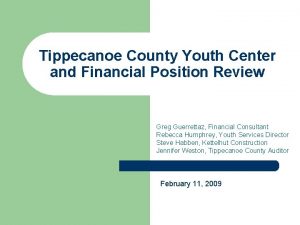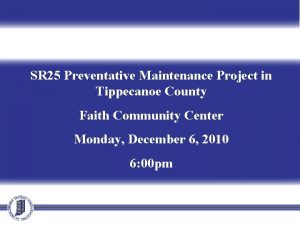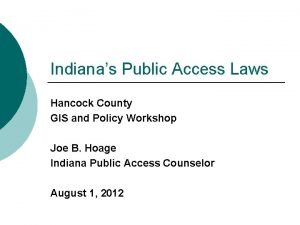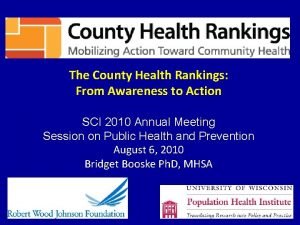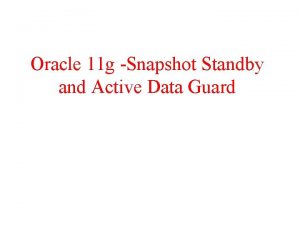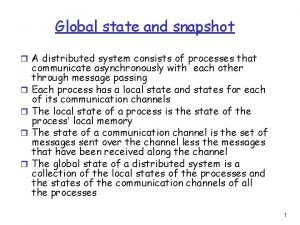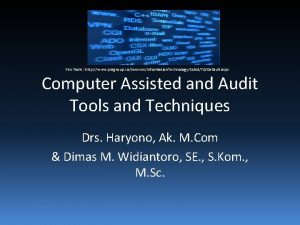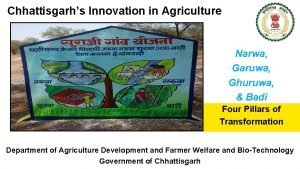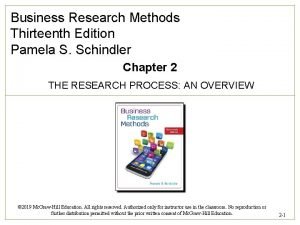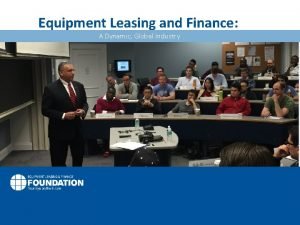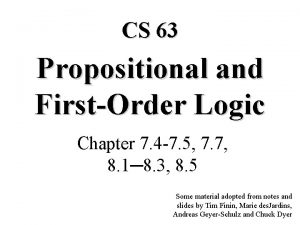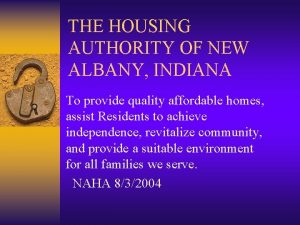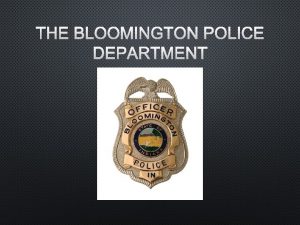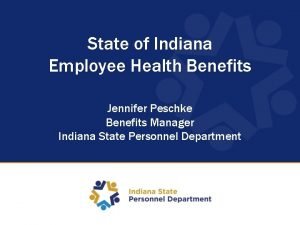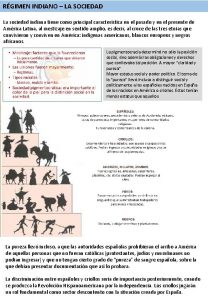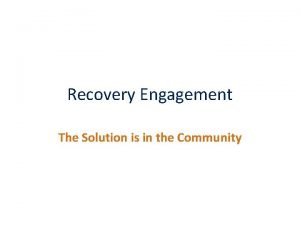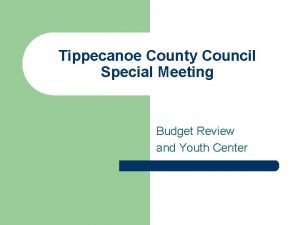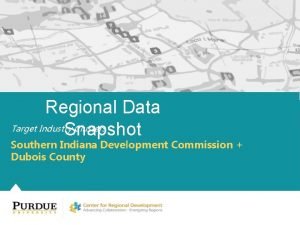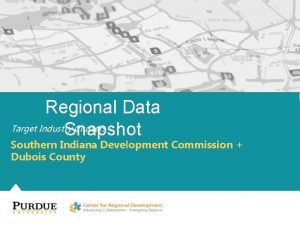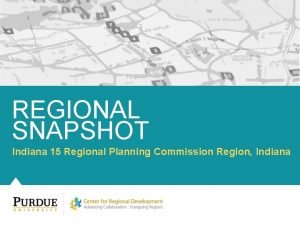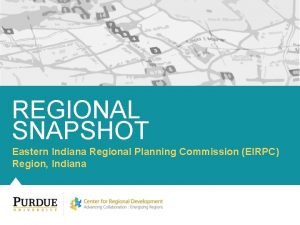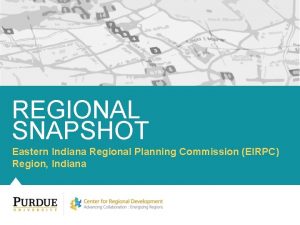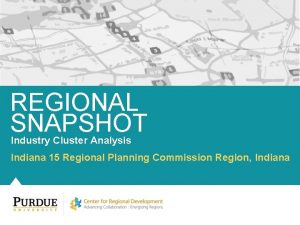Data Snapshot Tippecanoe County Indiana County Data Snapshot










![11 Demography Race Year 2000 [CELLRANGE] [PERCENTAGE ] Minority, [PERCENTAGE ] Year 2017 [CATEGORY 11 Demography Race Year 2000 [CELLRANGE] [PERCENTAGE ] Minority, [PERCENTAGE ] Year 2017 [CATEGORY](https://slidetodoc.com/presentation_image_h2/85e5ae2f4ac7751b1a7ac02792fcdb17/image-11.jpg)
![12 Demography Ethnicity 100% [CELLRANGE] [VALUE] 95% 90% 85% 80% 75% 70% 2000 [CELLRANGE] 12 Demography Ethnicity 100% [CELLRANGE] [VALUE] 95% 90% 85% 80% 75% 70% 2000 [CELLRANGE]](https://slidetodoc.com/presentation_image_h2/85e5ae2f4ac7751b1a7ac02792fcdb17/image-12.jpg)







































- Slides: 51

Data Snapshot Tippecanoe County Indiana County Data Snapshot Series February 2019 Tippecanoe County Courthouse, Indiana 1

Table of Contents 01 Introduction 02 Demography 03 Economy 04 Labor Market 05 Broadband Data Snapshot // Tippecanoe County 2

01 Introduction Purpose About Tippecanoe County

4 Introduction Purpose This document provides information and data about Tippecanoe County that can be used to guide local decision-making activities. The Data Snapshot showcases a variety of demographic, economic and labor market information that local leaders, community organizations and others can use to gain a better perspective on current conditions and opportunities in their county. Data Snapshot // Tippecanoe County To strengthen the value and usability of the information, we showcase the data using a variety of visual tools, such as charts, graphs and tables. In addition, we offer key points about the data as a way of assisting the user with the interpretation of the information presented. Finally, key comments and takeaways associated with the data messages are presented in the last section of this snapshot.

5 Introduction About Tippecanoe County Established 1826 County Seat Lafayette Area Neighboring Counties Metropolitan Classification EDA Distress Criteria 2017 Data Snapshot // Tippecanoe County 503. 24 sq. mi. White County Carroll County Clinton County Montgomery County Fountain County Warren County Benton County Metropolitan Statistical Area Distressed by income

02 Demography Population Change Population Pyramid Generational Chart Race Ethnicity Language Use Educational Attainment

7 Demography Population Change Total Population Projections 109 378 121 702 130 598 148 955 172 780 190 587 195 555 1970 1980 1990 2000 2017 2020 The county’s total population has expanded every decade since 1970, with an increase of 81, 209 individuals between 1970 and 2017. The county grew by nearly 28 percent (41, 632 persons) between 2000 and 2017. As for the 2010 to 2017 period, the population expanded by over 10 percent (17, 807 individuals). Since 2000, the key contributor to such increases has been international migration (people moving in from outside the U. S. versus people moving to countries outside the U. S. ) resulting in a net growth of nearly 21, 000 people over the 17 -year period. Natural Increase (births minus deaths) had a positive impact as well with a net growth of 19, 449 persons. Domestic Migration (number of people moving into the county minus moving out from the county to other parts of the state or the U. S) resulted in a net reduction of 1, 882 fewer individuals between 2000 and 2017. Data Snapshot // Tippecanoe County The total population is projected to increase by 2. 6 percent between 2017 and 2020. Components of Population Change, 2000 -2017 2000 -2010 -2017 Natural Increase 11, 275 8, 174 International Migration 9, 035 11, 472 143 -2, 025 19, 547 17, 542 Domestic Migration Total Change Sum of the components of population may not match to the actual change because of the residuals Sources: STATSIndiana, U. S. Census Bureau – 1990 Census, 2000 and 2010 Decennial Census, 2017 Annual Population Estimates

8 Demography Population Trend Comparison, 2001 -2017 1, 3 1, 2 Tippecanoe County 1, 1 1, 0 0, 9 2001 2002 2003 2004 2005 2006 2007 2008 2009 2010 2011 United States Metropolitan Population United States Nonmetropolitan Population Indiana Nonmetropolitan Population Tippecanoe County, IN Data Snapshot // Tippecanoe County 2012 2013 2014 2015 2016 2017 Indiana Metropolitan Population Sources: BEA

9 Demography Population Pyramids Year 2017 Year 2000 Male 80+ Female 70 -79 60 -69 50 -59 Age Cohort Female Male 80+ 40 -49 30 -39 20 -29 10 -19 0 -9 9 6 3 0 3 6 9 Percentage of the population The proportion of males and females in Tippecanoe County remained largely constant between 2000 and 2017. Approximately 48. 7 percent of the population was female in 2000, and that number increased slightly to 48. 9 by 2017. Bigger changes, however, occurred among various age groups in the county. For example, the proportion of individuals (males and females) 50 years of age and older expanded from 20. 6 percent to 25. 8 percent from 2000 to 2017. The oldest age group, those 80 years of age or more, increased from 2. 5 to 2. 9 percent in that time period. Data Snapshot // Tippecanoe County 9 6 3 0 3 6 9 Percentage of the population Several other age categories, on the other hand, suffered declines. The percentage of people under 20 years old fell 1. 8 percentage points from 2000 to 2017, although the proportion of individuals under 10 years old (age 0 -9) remained essentially unchanged (from 11. 8% to 11. 9%). While young adults (20 -29) represent the largest age cohort in the county at 25. 6% in 2017, the overall share of population of prime working age – those between 30 -49 years of age, experienced a downturn -- from 25. 1 percent to 21. 7 percent over the 2000 -2017 time span. Source: U. S. Census Bureau – 2000 Decennial Census and 2017 Annual Population Estimates Table names: Census 2000 SF 1 QTP 1, PEP 2017 PEPAGESEX

10 Demography Generational Chart, 2017 Silent Generation and Great Generation or the Lost Generation are 70 years and above. Some of them fought in Word Wars and experienced the Great Depression of 1930 s. Silent Generation Plus GI (70+ years) Baby Boomers is the generation after World War II. They are now 50 to 69 years old and they are at or nearing retirement age. They experienced the U. S. economic growth and prosperity. This is a large generational cohort with strong work ethics. Baby Boomers (50 -69 years) Generation X (35 -49 years) Generation X is now 35 to 50 years old. This generation has experienced technological advances (internet and automation) and tries to cope up with the new technology. Millenials (20 -34 years) Millennials are now 20 to 34 years old. This generation is diverse and has adapted to technology. Generation Z (<=19 years) - Male Female Data Snapshot // Tippecanoe County 10 000 20 000 30 000 40 000 50 000 60 000 70 000 Generation Z is in the teens and the most technologically savvy generation. Source: Population Estimates, U. S. Census Bureau
![11 Demography Race Year 2000 CELLRANGE PERCENTAGE Minority PERCENTAGE Year 2017 CATEGORY 11 Demography Race Year 2000 [CELLRANGE] [PERCENTAGE ] Minority, [PERCENTAGE ] Year 2017 [CATEGORY](https://slidetodoc.com/presentation_image_h2/85e5ae2f4ac7751b1a7ac02792fcdb17/image-11.jpg)
11 Demography Race Year 2000 [CELLRANGE] [PERCENTAGE ] Minority, [PERCENTAGE ] Year 2017 [CATEGORY NAME] [CELLRANGE] [PERCENTAGE] [CATEGORY NAME] Minority, [PERCENTAGE] [CATEGORY NAME] Note: Natives are comprised of American Indian and Alaskan Native, and Native Hawaiian and Other Pacific Islander. The number of White residents in Tippecanoe County decreased from 88. 9 percent to 83. 5 percent between 2000 and 2017. As a result, the percentage of non-White persons grew from 11. 1 percent to 16. 5 percent between 2000 and 2017. The number of African Americans/Blacks increased by 6, 725 individuals. The population of Asians also expanded by 4 percentage points, or 9, 539 individuals, by 2017. The Native population increased by 361 persons. Meanwhile, individuals with two or more races experienced a decrease (minus 1. 7 percentage point with 1, 690 fewer individuals) over the same time period. Data Snapshot // Tippecanoe County Source: U. S. Census Bureau – 2000 Decennial Census and 2017 Annual Population Estimates Table names: Census 2000 SF 1 P 008, PEP 2017 PEPSR 6 H
![12 Demography Ethnicity 100 CELLRANGE VALUE 95 90 85 80 75 70 2000 CELLRANGE 12 Demography Ethnicity 100% [CELLRANGE] [VALUE] 95% 90% 85% 80% 75% 70% 2000 [CELLRANGE]](https://slidetodoc.com/presentation_image_h2/85e5ae2f4ac7751b1a7ac02792fcdb17/image-12.jpg)
12 Demography Ethnicity 100% [CELLRANGE] [VALUE] 95% 90% 85% 80% 75% 70% 2000 [CELLRANGE] Non Hispanic [VALUE] Data Snapshot // Tippecanoe County 2017 Hispanics are individuals of any race whose ancestry is from Mexico, Puerto Rico, Cuba, Spain, the Dominican Republic or any other Spanish-speaking Central or South American country. There were 7, 834 Hispanics residing in Tippecanoe County in 2000. This population grew by over 16, 000 individuals by 2017. In terms of percentage growth, the Hispanic population expanded by 106 percent between 2000 and 2017. As such, the Hispanic community represents nearly 8. 5 percent of Tippecanoe County’s population as of 2017. [CELLRANGE] [VALUE] Source: Decennial Census, Population Estimates, U. S. Census Bureau

13 Demography Language Use 2000 2017 Speak Only English 124, 060 (88. 6%) 147, 426 (84. 4%) Speak a Language Other Than English 16, 033 (11. 4%) 27, 343 (15. 6%) Total 140, 093 174, 769 Top Three Languages Spoken at Home in 2000* Top Three Languages Spoken at Home in 2017* Spanish or Spanish Creole 7, 232 Spanish or Spanish Creole 10, 823 Chinese 1, 938 Asian and Pacific Island Languages 10, 464 Other Indo-European Languages 5, 225 French (incl. Patois, Cajun) 737 *Other than English Note: Language spoken at home (Age 5 years and more). ACS 2017 has much broader language categories. Data Snapshot // Tippecanoe County Source: Census ACS 5 -Year Estimates 2013 -2017, Census Summary Fact File 2000

14 Demography Educational Attainment Tippecanoe County’s share of adults (25 years and older) with Bachelors or higher degree increased by 3. 7 percentage points (11, 329 more individuals) from 2000 to 2017. The total number of adults 25+ years of age with associate’s degree increased by nearly 3 percentage points (3, 958 more individuals) from 2000 to 2017, while adults with some college education also increased by 6, 334 individuals over the 2000 to 2017 period. As for adults with a high school education, that figure dropped by about 6 percentage points over the 2000 -2017 span of time, while those with less than a high school education dipped by 3. 5 percentage points. Despite the challenges that less educated adults face in the workforce, nearly 9, 000 residents did not have a high school degree as of 2017. [CELLRA NGE], [PERCEN TAGE] [CELLRAN GE], [PERCENT AGE] [CELLRANGE], [PERCENTAGE] 2000 2017 [CELLRAN GE], [PERCENT AGE] Bachelor's or more [PERCENT AGE] No High School [PERCENT AGE] Some College [PERCENT AGE] Associate's, [PERCENTAGE] Data Snapshot // Tippecanoe County Source: U. S. Census Bureau – 2000 Decennial Census and 2017 ACS Table names: Census 2000 SF 4 QTP 20, ACS 2017 S 1501

03 Economy Establishments Occupations Industries Income and Poverty

16 Economy Components of Job Changes in Jobs (2003 -2017) New Start-ups Jobs 35, 990 Spin-offs 7, 841 Expansion 40, 539 Gained by In-migration Lost by Net Change Data Snapshot // Tippecanoe County How to Interpret the Accompanying Table 1, 182 Closings 53, 516 Contractions 24, 436 Out-migration 1, 248 New Start-ups A completely new business from births/openings without any affiliation to an existing business. In-migration Businesses that have moved-in from outside of the county. Spin-offs New businesses that were spun off from existing businesses. Contractions Existing businesses that have shed/reduced jobs. Expansions Existing businesses that have expanded in jobs. Out-migration Businesses that have movedout from the county. Closings Closure of existing businesses. 6, 352 Source: Your. Economy. org

17 Economy Company Stages Stage 2 20, 1% An establishment is a physical business location. Branches, standalones and headquarters are all considered types of establishments. Stage 4 0, 2% Stage 3 1, 5% Stage 0 12, 3% Definition of Company Stages Stage 1 65, 8% Stage 0 Self-employed Stage 1 2 -9 employees Stage 2 10 -99 employees Stage 3 100 -499 employees Stage 4 500+ employees Establishment Distribution by Stages Indiana, 2017 Data Snapshot // Tippecanoe County Note: Based on Edward Lowe’s research, http: //thegrowthsociety. com/links/Second. Stage. pdf/

18 Economy Number of Establishments, Jobs, Sales by Stage/Employment Category in the County Jobs* 2017 % Change (2003 -2017) Sales 2017 ($ 2017, Million) % Change (2003 -2017, $ 2017) 21. 8% 698 21. 8% 94. 0 -20. 0% 4, 173 17. 5% 17, 144 19. 9% 3, 300. 0 -0. 8% Stage 2 1, 395 10. 9% 33, 579 9. 0% 6, 200. 0 13. 7% Stage 3 99 4. 2% 16, 364 0. 5% 2, 800. 0 -22. 0% Stage 4 15 -23. 5% 34, 421 2. 8% 4, 600. 0 -61. 6% 6, 380 16. 1% 102, 206 7. 1% 16, 994 -30. 5% Establishments 2017 % Change (2003 -2017) Stage 0 698 Stage 1 Stage Total *Includes both full-time and part-time jobs Note: The change in jobs from 2003 to 2017 might not match with the components of change in jobs because of residuals. Data Snapshot // Tippecanoe County Source: Your. Economy. org

19 Economy Top Five Industries Approximately two-thirds of all jobs are tied to one of the top five industries in Tippecanoe County The top industry in Tippecanoe County is government, which accounts for 23 percent of the total jobs as of 2017 (with 24, 860 jobs). Manufacturing ranks second, providing 15, 875 jobs in 2017 while Health Care and Social Assistance represents about 11 percent of total jobs. Retail Trade, as well as Accommodation and Food Services complete the top five industries in Tippecanoe County. Collectively, the top five industries in Tippecanoe County provided 72, 498 jobs in 2017. All five top industries gained jobs between 2003 and 2017. Data Snapshot //Tippecanoe County 2003 All Other Industries 32% Government 24% 2017 Manufacturing 16% Accommodation and Food Services 8% Health Care and Social Assistance 10% All Other Industries 34% Government 23% Manufacturing 14% Retail Trade 10% Accommodati on and Food Services 8% Retail Trade 10% Health Care and Social Assistance 11% Source: EMSI – 2018. 4 – QCEW Employees, Non-QCEW Employees, Self-Employed, and Extended Proprietors

20 Economy Top Five Industries Jobs Trend (2001 -2017) 25 000 20 000 15 000 10 000 5 000 0 2001 2002 Government Data Snapshot // Tippecanoe County 2003 2004 2005 Manufacturing 2006 2007 2008 2009 Health Care and Social Assistance 2010 2011 2012 Retail Trade 2013 2014 2015 2016 2017 Accommodation and Food Services Source: EMSI– 2018. 4 – QCEW Employees, Non-QCEW Employees, Self-Employed, and Extended Proprietors

21 Economy Industry distribution and change Industries with the largest gains and losses in employment numbers between 2003 & 2017 Health Care and Social Assistance +3, 446 The largest percentage gains in employment occurred in Educational Services (+114%) Government +3, 416 Administrative and Support and Waste Management and Remediation Services (+86%) The largest percentage losses in employment occurred in Management of Companies and Enterprises (-40%) Information (-21%) Employment Decrease Construction -304 Information -246 Employment Increase Data Snapshot // Tippecanoe County Source: EMSI – 2018. 4 – QCEW Employees, Non-QCEW Employees, Self-Employed, and Extended Proprietors

22 Economy Top Five Occupations The top five occupations in Tippecanoe County represent more than half of all jobs. Office and Administrative Support Occupations (14, 628 jobs) is the top occupation, which accounts for 13 percent of the total jobs. Production Occupations rank second, providing 12, 769 jobs. Sales and Related Occupations constitute 10 percent of all jobs in the county. Food Preparation and Serving Related Occupations and Education, Training, and Library Occupations complete the top five occupation groups in Tippecanoe County. Together the top five occupation groups represented 56, 563 jobs in 2017. Worth noting is that all of the top five occupations gained jobs between 2003 and 2017. Data Snapshot // Tippecanoe County 2003 Office and Administrative Support Occupations 15% Production Occupations 11% All Other Occupations 47% Education, Training, and Library Occupations 8% Sales and Related Occupations 11% Food Preparation and Serving Related Occupations 8% 2017 Office and Administrative Support Occupations 13% Production Occupations 12% All Other Occupations 48% Sales and Related Occupations 10% Food Preparation and Serving Related Occupations 9% Education, Training, and Library Occupations 8% Source: Economic Modeling Specialists International (EMSI) – 2018. 4 – QCEW Employees, Non-QCEW Employees, Self-Employed, and Extended Proprietors

23 Economy Top Five Occupation jobs Trend (2001 -2017) 16 000 14 000 12 000 10 000 8 000 6 000 4 000 2 000 0 2001 2002 2003 2004 2005 2006 2007 2008 2009 2010 2011 Office and Administrative Support Occupations Production Occupations Food Preparation and Serving Related Occupations Education, Training, and Library Occupations Data Snapshot //Tippecanoe County 2012 2013 2014 2015 2016 2017 Sales and Related Occupations Source: Economic Modeling Specialists International (EMSI) – 2018. 4 – QCEW Employees, Non-QCEW Employees, Self-Employed, and Extended Proprietors

24 Economy Occupation distribution and change Occupations with the largest gains and losses in employment numbers between 2003 & 2017 Food Preparation and Serving Related Occupations + 2, 299 Production Occupations + 2, 094 Employment Increase Data Snapshot // Tippecanoe County The largest percentage gains in employment occurred in The largest percentage losses in employment occurred in Personal Care and Service Occupations (+57%) Construction and Extraction Occupations (-8%) Community and Social Service Occupations (+52%) Farming, Fishing, and Forestry Occupations (-2%) Employment Decrease Construction and Extraction Occupations -338 Farming, Fishing, and Forestry Occupations -9 Source: EMSI – 2018. 4 – QCEW Employees, Non-QCEW Employees, Self-Employed, and Extended Proprietors

25 Economy Income and Poverty 2001 2009 2017 Total Population in Poverty 10. 5% 20. 9% 18. 0% Minors (Under Age 18) in Poverty 10. 9% 19. 0% 16. 1% Real Median Household Income ($2017)* $54, 546 $47, 889 $52, 858 Real Per Capita Income ($2017)* $34, 720 $33, 794 $36, 907 2000 2008 2017 Percent of Household in Upper Income Bracket ($100, 000 +)** 9. 5% 14. 4% 19. 6% Percent of Household in the Lowest Income Bracket (Less than $30, 000)** 39. 3% 36. 0% 31. 3% Median household income in Tippecanoe County dropped by $1, 688 between 2001 and 2017 in real dollars (that is, adjusted for inflation), while average income person increased by $2, 187 real dollars over the same period. It is worth noting that the total population in poverty increased dramatically from 10. 5 percent to 18 percent between 2001 and 2017. Child poverty also expanded by more than 5 percentage points during this same time period. The GINI Index of income inequality for households in Tippecanoe County was 0. 4716 in 2017 (ACS 2013 -2017), a marginal increase from 0. 4681 in 2012 (ACS 2008 -2012). *Real median household income is the middle income value in the county. Half of the county’s households fall above this line and half below. Real per capita personal income is the average income person in the county. **Percent of household in upper income bracket: 2017 is 5 year ACS, 2008 is 3 year ACS, 2000 is Census summery file 3 (SF-3). ***GINI Index measures income inequality. The higher values indicate more inequality or more wealth concentrated in a small percentage of the population. Data Snapshot // Tippecanoe County Source: SAIPE, ACS 2013 -2017, BEA- Regional Personal Income Summary

26 Economy Income and Poverty (3 years rolling average) Median household income in Tippecanoe County has been fluctuating since 2003 with declines witnessed after the Great Recession (2007 -2009). Real per capita personal income has been largely stable with a slight uptick since 20105 The poverty rate for all ages had been rising since 2003, but has improved since 2014. Poverty among minors (children under 18 years of age) also has grown since 2003, peaking at 20. 4 percent in 2012. Child poverty has been declining since 2012. $60 000 21% Median Household Income $50 000 19% All Ages in Poverty 15% $30 000 Per capita Income 13% Percent(%) Dollars ($) 17% Minor in Poverty $40 000 11% $20 000 9% $10 000 7% $0 5% 2003 2004 2005 2006 2007 2008 2009 2010 2011 2012 2013 2014 2015 2016 2017 Note: Ending point is shown as the time period. Data Snapshot // Tippecanoe County Source: SAIPE, BEA- Regional Personal Income Summary

27 Economy Cost of Living and Affordability Transportation Costs (% of income) Cost of Living Index Affordable House Units (per 10, 000 people) Indiana 26% - 26% 93 130 - 94 156 35% 30% Percentage of Income Housing Costs (% of income) Tippecanoe County 26% Housing Costs Transportation Costs 25% 20% 15% 10% 5% 0% COLI is a cost of living index comparing regions with average U. S. values based on price differences in consumer goods and services for six major categories (grocery items, housing and utilities, transportation, health care and miscellaneous goods and services). For Tippecanoe County, the COLI (index) is 93, white it is 94 for Indiana and 100 for the U. S. Housing and transportation costs are measured at the county scale. Combined, the value exceeds the 45% of housing income threshold dedicated for these type of expenses, raising a concern about affordability in Tippecanoe County. Housing cost is within the 30% threshold, but transportation costs exceed the 15% threshold. Affordable and subsidized housing units in this county is at 130 units per 10, 000 people, lower than the 156 units per 10, 000 people for the state of Indiana. Source: H+T CNT, EMSI, AARP Data Snapshot // Tippecanoe County

04 Labor Market Labor Force & Unemployment Commuteshed Laborshed Workforce Inflow/Outflow

29 Labor Market Labor Force and Unemployment Labor Force Unemployment Rate Labor Force Participation Rate Data Snapshot // Tippecanoe County 2003 2010 2017 77, 577 86, 531 94, 220 4. 7% 8. 9% 4. 0% 71. 5% 71. 6% 73. 6% The number of individuals in the labor force of Tippecanoe County increased between 2003 and 2017. The number of individuals in the county’s labor force increased by 16, 643 individuals between 2003 and 2017. Among individuals in the labor force, 95. 3 percent were employed in 2003, growing to 96 percent in 2017. Worth noting is that the labor participation rate in Tippecanoe County (73. 6%) was lower than Indiana’s average labor participation rate of 81. 6% in 2017. There may be a variety of factors associated with the lower labor participation rate, including discouraged workers who dropped out of the labor force after the Great Recession or the fact that many younger adults not in the work force in the county are college students attending Purdue University or Ivy Tech College. Source: BLS, Stats Indiana

30 Labor Market Unemployment Rate The unemployment rate increased in Tippecanoe County during the later part of 2000 decade, peaking at 9. 1 percent in 2009 after the Great Recession. Since that time, the rate has been on a steady decline, dropping to 3. 2 percent by 2017. 12, 0% Tippecanoe County Rate Indiana rate US rate 10, 4% 10, 0% Unemployment rate 9, 1% 9, 6% 8, 9% 8, 0% 7, 7% 8, 1% 7, 4% 5, 8% 6, 0% 5, 2% 4, 7% 5, 8% 6, 0% 6, 6% 5, 3% 5, 5% 5, 3% 4, 6% 5, 1% 4, 9% 4, 4% 3, 9% 4, 6% 4, 3% 4, 0% 6, 2% 5, 9% 4, 2% 3, 5% 4, 0% 3, 2% 2, 0% 0, 0% 2001 Data Snapshot // Tippecanoe County 2002 2003 2004 2005 2006 2007 2008 2009 2010 2011 2012 2013 2014 2015 2016 2017 Source: BLS

31 Labor Market Journey to Work 35, 68 4 50, 614 In-Commuters Tippecanoe County has more workers commuting in than commuting out from the county for work. Net commuting is positive with a surplus of 11, 445 commuters. For every 100 employed residents, there approximately 115 jobs in the county. This suggests that the county is serving as a job center for the region. Same Work/Home 24, 23 9 Out-Commuters 2015 Count Proportion Living in Tippecanoe County 74, 853 100. 0% Both living and employed in the County 50, 614 67. 6% Living in the County but employed outside 24, 239 32. 4% Employed in Tippecanoe County 86, 298 100. 0% Both employed and living in the County 50, 614 58. 7% Employed in the County but living outside 35, 684 41. 3% Source: On The Map Data Snapshot // Tippecanoe County

32 Labor Market Flow of Earnings 2003 2010 2017 $1 200 000 2003 2010 2017 $1 000 Outflow of Earnings (000’s of $ 2017) $259, 093 $902, 683 $410, 229 $977, 084 $800 000 $433, 521 $1, 109, 274 Thousands of Dollars Inflow of Earnings (000’s of $ 2017) $600 000 $400 000 $200 000 $0 -$200 000 -$400 000 Net Flow of Earnings (000’s of $ 2017) -$643, 590 -$566, 855 -$675, 753 -$600 000 -$800 000 Inflow of Earnings • Outflows of Earnings Net Flows of Earnings A negative net flow of earnings indicates that total earnings of the labor force (non-residents of the county who work in Tippecanoe County) exceed the total earnings of commuters (residents who work outside of the county). Source: BEA Data Snapshot // Tippecanoe County

33 Labor Market Commuteshed & Laborshed in 2015 35, 684 24, 239 Illinois Indiana Data Snapshot // Tippecanoe County Indiana Source: On The Map

34 Labor Market Commuteshed in 2015 Seventy-five percent of employed Tippecanoe’s residents commute to Tippecanoe and Marion counties. Another 5 percent commute to Hamilton, Clinton, and Howard counties. Lake, White, Hendricks, Carroll, and Montgomery counties of Indiana are added if the commuter shed is extended to 85 percent. Collectively, these 10 counties represent roughly 85 percent of the commuteshed for Tippecanoe County. Commuters Proportion Tippecanoe County, IN 50, 614 67. 6% Marion County, IN 5, 534 7. 4% Hamilton County, IN 1, 437 1. 9% Clinton County, IN 1, 324 1. 8% Howard County, IN 1, 052 1. 4% A county’s commuteshed is the geographic area to which its resident labor force travels to work. Approximately one third of employed residents commute to different counties for jobs. Other than Tippecanoe itself, Marion County of Indiana is the destination that has the most commuters from Tippecanoe County, accounting for 7. 4 percent of its total employed residents. Hamilton and Clinton counties follow as the second and the third largest destinations with 1. 9 and 1. 8 percent of commuters, respectively. Nearly 6 percent of commuters work in counties that are adjacent to Tippecanoe County. Source: On The Map Data Snapshot // Tippecanoe County

35 Labor Market Laborshed in 2015 Nearly seventy-five percent of the County’s workforce is drawn from Tippecanoe, Carroll, Marion, Clinton, White, Hamilton and Lake counties. Montgomery, Benton, Allen, and Fountain counties are included in the laborshed when the threshold is extended to 80 percent. St. Joseph, Warren, Howard, Jasper, Porter counties, as well as Cook County in Illinois, are part of the 85 percent laborshed. Combined, these 17 counties represent 85 percent of Tippecanoe County’s laborshed. Commuters Proportion Tippecanoe County, IN 50, 614 58. 7% Carroll County, IN 2, 713 3. 1% Marion County, IN 2, 606 3. 0% Clinton County, IN 2, 491 2. 9% White County, IN 2, 491 2. 9% Data Snapshot // Tippecanoe County A county’s laborshed is the geographic area from which it draws employees. More than 40 percent of individuals working in Tippecanoe County commute from different counties. Carroll County is the largest source of workers, contributing 3. 1 percent of the employees in Tippecanoe County. Marion, Clinton, and White counties complete the top five sources of workers. In addition, 14. 2 percent of in-commuters reside in counties adjacent to Tippecanoe County Source: On The Map

Section 05 Broadband Data Snapshot //Tippecanoe County 36

Broadband Data Snapshot // Tippecanoe County 37 Population with no access to broadband 25/3, 2017 Source: FCC; 2017 Tiger/Lines Census Tracts

38 Broadband The Digital Divide Index or DDI ranges in value from 0 to 100, where 100 indicates the highest digital divide. It is composed of two scores, also ranging from 0 to 100: the infrastructure/adoption (INFA) score and the socioeconomic (SE) score. The INFA score groups five variables related to broadband infrastructure and adoption: 1. percentage of total 2010 population without access to fixed broadband of at least 25 Mbps download and 3 Mbps upload 2. households with no internet access (not subscribing) 3. households without a computing device 4. average maximum advertised download speeds; and 5. average maximum advertised upload speeds. The SE score groups four variables known to impact technology adoption: 1. percent population ages 65 and over 2. percent population 25 and over with less than high school 3. individual poverty rate; and 4. percent of noninstitutionalized civilian population with a disability. In other words, these variable indirectly measure adoption since they are potential predictors of lagging technology adoption. These two scores are combined to calculate the overall DDI score. If a particular county or census tract has a higher INFA score versus a SE score, efforts should be made to improve broadband infrastructure. If on the other hand, a particular geography has a higher SE score versus an INFA score, efforts should be made to increase digital literacy and exposure to the technology’s benefits. Data Snapshot // Tippecanoe County Source: DDI, PCRD

39 Broadband 2017 Digital Divide Profile Score 28. 85 Digital Divide Index Score Infrastructure/Adoption Score Average maximum advertised download speed in Mbps 13. 64 318. 70 Average maximum advertised upload speeds in Mbps 18. 97 People without access to fixed broadband of at least 25/3 Mbps 7. 5% Households with no internet access (not subscribing) Households without a computer device Data Snapshot // Tippecanoe County Score Socioeconomic Score Population ages 65 and older Ages 25 and older with less than a high school degree 43. 79 11. 0% 8. 7% Individuals in poverty 20. 9% Noninstitutionalized civilian population with a disability 10. 9% 12. 8% 7. 7% Source: FCC Form 477; 2013 -2017 ACS

40 Concluding Comments Data Snapshot // Tippecanoe County

41 Demography: Concluding Comments • • • Tippecanoe County’s population has witnessed a growing trend since the decade of the 1970 s, and this trend is projected to continue. If the past trends hold, that increase will be the result of international migration as well as natural increase (more births than deaths). The impact of Purdue University and Ivy Tech Community College on the demographics of Tippecanoe County is evident in the large number of international migrants, as well as the sizable number of young adults (20 -29 years old) who make-up the county’s population in 2017 (25. 6 percent). On the other hand, the population over 50 has swelled, representing nearly 26 percent of the county’s population in 2017. That shift may have important implications for Tippecanoe County regarding the need for health care, housing, transportation options, and more. More than 1 in 4 persons are 19 years of age or younger (Generation Z), meaning that education, recreational activities, child care and after-school programs for young people will be important. This is also a technologically savvy generation that has a high appreciation for digital connectivity. Data Snapshot // Tippecanoe County Education Race and Ethnicity Population • • Due, in part, to the presence of Purdue University and Ivy Tech Community College, Tippecanoe County has a relatively high level of racial and ethnic diversity. While the county’s population remains primarily white and non-Hispanic, nearly 17 percent of the population is now non-white. Asians and Blacks increased by 4 and 3 percentage points, respectively, from 2000 to 2017. Tippecanoe County has become more ethnically diverse over the past 17 years. Around 8. 5 percent of Tippecanoe County’s residents (16, 141 individuals) is now of Hispanic origin, a significant increase from the 5. 3 percent recorded in 2000. • This trend is consistent with the evidence of increasing proportions of residents who speak languages other than English – increasing from 11. 4 to 15. 6 percent between 2000 and 2017. More than 10, 000 individuals speak Spanish or Asian languages at home (as of 2017). • The growing diversity of the county means that local leader must continue to find ways to address the needs of a growing population in the county where English is not be the primary language. • With the presence of higher education institutions, Tippecanoe County has an impressive number of adults 25 years old and over with high educational attainment relative to the state. The 37 percent of adults with a Bachelor’s degree of higher is more sizable than the state figure of 25. 3 percent. • Attracting and retaining talent in Tippecanoe County will require a continued focus on ensuring that highskilled jobs exist that align with the training and skills of these young adults, Moreover, having the mix of services and amenities these individuals are looking for is of importance as well. • From 2000 to 2017, adults 25 years of age or older with associate’s degree increased by 3 percentage points. Those with some college education increased by 2 percentage points (+6, 334 individuals). Together, individuals with associates degrees or some college education make up almost 30 percent of the adult population. • Despite the higher educational attainment of adults, nearly 34 percent of adults have a high school or less than high school education. Exploring ways to enhance their work-related skills will be important to their ability to secure or retain a job in the county.

42 Economy: Concluding Comments Establishment and Industry • Tippecanoe County experienced a positive growth in the number of establishments between 2003 and 2017. A large proportion of that growth occurred among Stage 1 and Stage 2 enterprises, as well proprietors -- the very companies that often get overlooked by the local government and economic development authorities when exploring ways to add jobs to the local economy. • When it comes to jobs, Stage 1 companies (2 -9 employees) added 2, 851 jobs, while Stage 2 firms (10 -99 employees) experienced a growth of 2, 775 new jobs. Stage 3 (plus 80) and stage 4 (plus 942) also expanded jobs from 2003 to 2017, but at a much slower pace. Results suggest the need to focus attention on retaining and growing Stage 1 and 2 enterprises in Tippecanoe County. • Government has been a significant sector in the county, employing 24, 860 individuals with average earnings of $61, 499 in 2017. This includes Purdue University and Ivy Tech employees. Manufacturing sector provided 15, 875 jobs with nearly $82, 000 average total earnings. Continuing efforts to build a diverse economy represents a smart strategy for the county. Data Snapshot // Tippecanoe County Income and Poverty Occupation • • All five top occupations in Tippecanoe County gained jobs between 2003 and 2017. Office and Administrative Support Occupations expanded by 1, 169 jobs, and Production Occupations grew by 2, 094 jobs. Education, Training, and Library occupations, with median hourly earnings of $21, and Healthcare Practitioners occupations paying $27 hourly, grew by 16 and 38 percent, respectively. Given the good mix of occupations in the region, a key focus of local leaders is to retain a larger share of the talent being produced by Purdue University and Ivy Tech Community College, especially those with middle-to-high level skills. What is worth noting is that several occupations that experienced sizable growth between 2003 and 2017 currently provide fairly low median hourly earnings. For example, Healthcare Support Occupations grew by 40 percent and pays about $13. 50 an hour. Food Preparation and Serving related occupations added nearly 2, 300 jobs over the 2003 -2017 time span, but provide a median hourly wage of $9. 44. Moreover, Personal Care and Service occupations experienced a 57 percent increase over the two time periods, but pays less than $11 an hour. • Poverty levels in the county experienced a steady increase over the 2003 to 2011 period, reaching its peak at the end of the Great Recession. In particular, the overall poverty rate increased from 11. 5 percent in 2003 to over 21 percent by 2011. Child poverty followed a similar trend over the 20032017 period and sits at 16. 7 percent as of 2017. While the rates today are much lower than they were in 2011, both the overall and child poverty rates remain stubbornly high and trying to find the root causes of these sizable numbers is worth exploring. • Real median household income decreased in the county by $1, 688 between 2001 and 2017. On the other hand, real per capita income increased significantly by $2, 187 from 2001 to 2017. This seemingly conflicting trend indicates that there may be a growing income inequality occurring in the county. This means that there is a segment of the population that is becoming wealthier while another segment is losing ground in terms of wealth accumulation. • A case in point are residents who fall in the upper income ladder. The percent of household in the upper income bracket earning $100, 000 per annum increased by more than 10 percentage points from 2000 to 2017. At the same time, the percent of households in the lowest income bracket earning less than $30, 000, while declining over time, remained over 31 percent in 2017.

43 Labor Market: Concluding Comments Labor Force and Unemployment • Tippecanoe County experienced an annual high unemployment rate of 9. 1 percent in 2009. Since that time, the county’s unemployment rate has tumbled to 3. 2 percent in 2017, a rate that is lower than U. S. rate (4. 4 percent) and Indiana’s rate of 3. 5 percent. • In 2003, 77, 577 individuals were part of labor force and this number increased to 94, 220 in 2017. Nearly 96 percent of the present labor force are employed. Over the same period of time, the labor force participation rate increased from 71. 5 to 73. 6. Despite the growth of labor participation rate, this number is lower than the Indiana average of 81. 6%. The difference is due, in part, to larger number of individuals of working who are students at Purdue University or Ivy Tech Community College. Another factor may be the presence of discouraged workers who have been unable to find a job in the county that aligns with their education or work experiences. • Tippecanoe County has negative net flow of earnings in 2017 since the outflow of earnings excesses the inflow of earnings. This is the result of the large number of employees in the county who live outside the county, thus taking their earnings to their home residence. . Data Snapshot // Tippecanoe County Broadband Commuteshed and Laborshed • Other than Tippecanoe County itself, Carroll, Marion, Clinton, White, Lake, and Hamilton counties were the largest source of labor force for Tippecanoe County. Meanwhile, Marion, Hamilton, Howard, and Clinton counties also served as the major job destinations for workers commuting out of Tippecanoe County. • Approximately 14. 2 percent of Tippecanoe County’s labor force is coming from adjacent neighboring counties. It may be worthwhile to assess how interested these individual might be in moving to Tippecanoe County at some point in the future, and if not, what factors are preventing them from doing so. • Only 6 percent of adults from Tippecanoe County are working in adjacent neighboring counties as the Indianapolis metropolitan area is the major job destination. Given the fact that the net flow of earning is negative in 2017, it is possible that this outflow of labor is due to the fact that the human capital credentials of these individuals may be at odds with jobs that may be available in the county. • The census tract level data from Federal Communications Commission (FCC) indicate that significant areas of Tippecanoe County has either full or moderate levels of connectivity. The census tract located to the South has the highest gap in connectivity with nearly 71 percent residents have no access to 25/3 broadband. • Tippecanoe County’s population has on average 7. 5 percent of individuals without access to fixed broadband of at least 25/3 Mbps – the rate that the FCC states is required to have decent broadband service, 25 Mbps down and 3 Mbps up. • Tippecanoe County has a Digital Divide Index of 28. 9, where 100 indicates the largest digital divide. Similarly, infrastructure/adoption score for Tippecanoe County is nearly 14 compared to the socioeconomic score of 44. Given that the socioeconomic score is higher, it would make sense to focus on enhancing the digital literacy of people and businesses. Activities could include efforts to promote the benefits of broadband, informing people of the exciting ways that technology can be applied, and demonstrating the economic value of having digital connectivity for the household and community.

Appendix

Appendix NAICS Code Description 45 Economy - Industry Distribution and Change Jobs 2003 Jobs 2017 Change (2003 -2017) % Change (2003 -2017) Average Total Earnings 2017 1, 042 962 -80 -8% $38, 122 11 Agriculture, Forestry, Fishing and Hunting 21 Mining, Quarrying, and Oil and Gas Extraction 52 47 -5 -10% $64, 905 22 Utilities 98 86 -12% $110, 839 23 Construction 4, 491 4, 187 -304 -7% $55, 096 31 Manufacturing 14, 706 15, 875 1, 169 8% $82, 061 42 Wholesale Trade 1, 392 2, 089 697 50% $59, 900 44 Retail Trade 10, 488 10, 678 190 2% $28, 779 48 Transportation and Warehousing 1, 771 2, 628 857 48% $46, 733 51 Information 1, 193 947 -246 -21% $44, 791 52 Finance and Insurance 3, 209 3, 048 -161 -5% $63, 432 53 Real Estate and Rental and Leasing 2, 769 4, 305 1, 536 55% $35, 434 54 Professional, Scientific, and Technical Services 3, 588 4, 682 1, 094 30% $51, 328 55 Management of Companies and Enterprises 362 217 -145 -40% $115, 567 56 Administrative and Support and Waste Management and Remediation Services 2, 790 5, 182 2, 392 86% $28, 647 61 Educational Services 706 1, 513 807 114% $15, 799 62 Health Care and Social Assistance 8, 808 12, 254 3, 446 39% $55, 023 71 Arts, Entertainment, and Recreation 1, 028 1, 380 352 34% $11, 005 72 Accommodation and Food Services 6, 936 8, 831 1, 895 27% $18, 360 81 Other Services (except Public Administration) 4, 339 5, 640 1, 301 30% $25, 508 90 Government 21, 444 24, 860 3, 416 16% $61, 499 All Total 91, 217 109, 411 18, 194 20% $50, 162 Data Snapshot // Tippecanoe County Note: Average total earnings include wages, salaries, supplements and earnings from investments and proprietorships.

46 Appendix NAICS Description Code 11 Agriculture, Forestry, Fishing and Hunting 21 Economy - Industry Distribution and Change QCEW 2003 Jobs QCEW 2017 Jobs QCEW Jobs % Change (2003 -2017) Total Jobs 2003 Total Jobs 2017 Total Jobs % Change (2003 -2017) QCEW Average Total Earnings 2017 335 226 -33% 1, 042 962 -80 $51, 098 Mining, Quarrying, and Oil and Gas Extraction 52 30 -42% 52 47 -5 $99, 062 22 Utilities 96 79 -18% 98 86 -12 $116, 197 23 Construction 3, 142 2, 975 -5% 4, 491 4, 187 -304 $67, 120 31 Manufacturing 14, 570 15, 590 7% 14, 706 15, 875 1, 169 $85, 758 42 Wholesale Trade 1, 270 1, 730 36% 1, 392 2, 089 697 $67, 701 44 Retail Trade 9, 060 9, 238 2% 10, 488 10, 678 190 $30, 921 48 Transportation and Warehousing 1, 332 1, 981 49% 1, 771 2, 628 857 $51, 299 51 Information 995 685 -31% 1, 193 947 -246 $53, 240 52 Finance and Insurance 2, 476 1, 921 -22% 3, 209 3, 048 -161 $77, 639 53 Real Estate and Rental and Leasing 952 1, 304 37% 2, 769 4, 305 1, 536 $45, 835 54 Professional, Scientific, and Technical Services 1, 742 2, 372 36% 3, 588 4, 682 1, 094 $72, 956 55 Management of Companies and Enterprises 349 194 -44% 362 217 -145 $122, 932 56 Administrative and Support and Waste Management and Remediation Services 2, 042 4, 306 111% 2, 790 5, 182 2, 392 $32, 210 61 Educational Services 157 314 100% 706 1, 513 807 $30, 069 62 Health Care and Social Assistance 7, 803 11, 228 44% 8, 808 12, 254 3, 446 $55, 775 71 Arts, Entertainment, and Recreation 497 623 25% 1, 028 1, 380 352 $15, 318 72 Accommodation and Food Services 6, 817 8, 554 25% 6, 936 8, 831 1, 895 $18, 690 81 Other Services (except Public Administration) 2, 042 2, 281 12% 4, 339 5, 640 1, 301 $38, 502 90 Government 16, 496 17, 756 8% 21, 444 24, 860 3, 416 $83, 506 72, 232 83, 386 15% 91, 217 109, 411 18, 194 $60, 245 All Total Data Snapshot // Tippecanoe County Note: Average total earnings include wages, salaries, supplements and earnings from investments and proprietorships.

47 Appendix SOC Description Economy - Occupation Distribution and Change Jobs 2003 Jobs 2017 Change (2003 -2017) % Change (2003 -2017) Median Hourly Earnings 2017 (Total Jobs) 11 Management Occupations 5, 065 6, 469 1, 404 28% $29. 37 13 Business and Financial Operations Occupations 3, 387 4, 230 843 25% $27. 23 15 Computer and Mathematical Occupations 1, 447 1, 929 482 33% $27. 18 17 Architecture and Engineering Occupations 1, 198 1, 481 283 24% $33. 60 19 Life, Physical, and Social Science Occupations 970 1, 029 59 6% $26. 64 21 Community and Social Service Occupations 1, 283 1, 956 673 52% $19. 53 23 Legal Occupations 370 372 2 1% $27. 18 25 Education, Training, and Library Occupations 7, 149 8, 318 1, 169 16% $21. 12 27 Arts, Design, Entertainment, Sports, and Media Occupations 2, 130 2, 690 560 26% $14. 90 29 Healthcare Practitioners and Technical Occupations 4, 391 6, 039 1, 648 38% $26. 92 31 Healthcare Support Occupations 1, 594 2, 236 642 40% $13. 52 33 Protective Service Occupations 1, 186 1, 666 480 40% $19. 75 35 Food Preparation and Serving Related Occupations 7, 064 9, 363 2, 299 33% $9. 44 37 Building and Grounds Cleaning and Maintenance Occupations 4, 007 4, 513 506 13% $11. 14 39 Personal Care and Service Occupations 2, 654 4, 180 1, 526 57% $10. 79 41 Sales and Related Occupations 10, 097 11, 485 1, 388 14% $13. 25 43 Office and Administrative Support Occupations 13, 459 14, 628 1, 169 9% $15. 50 45 Farming, Fishing, and Forestry Occupations 375 366 -9 -2% $13. 78 47 Construction and Extraction Occupations 4, 260 3, 922 -338 -8% $19. 62 49 Installation, Maintenance, and Repair Occupations 3, 470 3, 979 509 15% $19. 11 51 Production Occupations 10, 675 12, 769 2, 094 20% $18. 45 53 Transportation and Material Moving Occupations 4, 679 5, 465 786 17% $15. 98 55 Military occupations 246 259 13 5% $18. 61 All Total 91, 217 109, 411 18, 194 20% Data Snapshot // Tippecanoe County *Management occupations include farm managers, so changes in jobs may be related to changes in the number of farm proprietorships.

48 Appendix SOC Description Economy - Occupation Distribution and Change QCEW 2003 Jobs QCEW 2017 Jobs 11 Management Occupations 3, 357 4, 160 13 Business and Financial Operations Occupations 2, 359 2, 745 15 Computer and Mathematical Occupations 1, 054 1, 414 17 Architecture and Engineering Occupations 1, 027 1, 318 19 Life, Physical, and Social Science Occupations 796 838 21 Community and Social Service Occupations 873 1, 389 23 Legal Occupations 267 266 25 Education, Training, and Library Occupations 6, 381 6, 928 27 Arts, Design, Entertainment, Sports, and Media Occupations 793 786 29 Healthcare Practitioners and Technical Occupations 4, 010 5, 587 31 Healthcare Support Occupations 1, 395 1, 868 33 Protective Service Occupations 950 1, 326 35 Food Preparation and Serving Related Occupations 6, 836 37 Building and Grounds Cleaning and Maintenance Occupations 39 QCEW Jobs % Change (2003 -2017) 24% 16% 34% 28% 5% 59% 0% 9% -1% 39% 34% Total Jobs 2003 Total Jobs 2017 Total Jobs % Change (2003 -2017) 28% 25% 33% 24% 6% 52% 1% 16% 26% 38% 40% Median Hourly Earnings 2017 (QCEW Jobs) $46. 85 $29. 32 $30. 93 $36. 41 $26. 94 $20. 91 $30. 91 $28. 67 $24. 58 $31. 53 $13. 99 5, 065 6, 469 3, 387 4, 230 1, 447 1, 929 1, 198 1, 481 970 1, 029 1, 283 1, 956 370 372 7, 149 8, 318 2, 130 2, 690 4, 391 6, 039 1, 594 2, 236 40% 1, 186 1, 666 40% $19. 85 8, 969 31% 7, 064 9, 363 33% $10. 57 2, 804 2, 902 3% 4, 007 4, 513 13% $12. 96 Personal Care and Service Occupations 1, 298 2, 105 62% 2, 654 4, 180 57% $12. 74 41 Sales and Related Occupations 6, 876 7, 258 6% 10, 097 11, 485 14% $14. 87 43 Office and Administrative Support Occupations 10, 340 10, 188 -1% 13, 459 14, 628 9% $16. 07 45 Farming, Fishing, and Forestry Occupations 321 231 -28% 375 366 -2% $15. 44 47 Construction and Extraction Occupations 3, 138 2, 853 -9% 4, 260 3, 922 -8% $24. 28 49 Installation, Maintenance, and Repair Occupations 2, 814 3, 192 13% 3, 470 3, 979 15% $20. 36 51 Production Occupations 10, 395 12, 438 20% 10, 675 12, 769 20% $19. 86 53 Transportation and Material Moving Occupations 4, 150 4, 625 11% 4, 679 5, 465 17% $18. 23 55 Military occupations 0 0 0% 246 259 5% $0. 00 All Total 72, 232 83, 386 15% 91, 217 109, 411 20% $21. 27 Data Snapshot // Tippecanoe County Note: Average total earnings include wages, salaries, supplements and earnings from investments and proprietorships.

49 Appendix Notes LAUS (Local Area Unemployment Statistics): LAUS is a U. S. Bureau of Labor Statistics (BLS) program that provides monthly and annual labor force, employment and unemployment data by place of residence at various geographic levels. LAUS utilizes statistical models to estimate data values based on household surveys and employer reports. These estimates are updated annually. Annual county-level LAUS estimates do not include seasonal adjustments. OTM (On the Map): OTM, a product of LEHD program, is used in the county snapshot report to develop commuting patterns for a geography from two perspectives: place of residence and place of work. At the highly detailed level of census blocks, some of the data are synthetic to maintain confidentiality of the worker. However, for larger regions mapped at the county level, the commuter shed and labor shed data are fairly reasonable. LEHD (Longitudinal Employer-Household Dynamics): LEHD is a partnership between U. S. Census Bureau and State Department of Workforce Development (DWD) to provide labor market and journey to work data at various geographic levels. LEHD uses Unemployment Insurance earnings data and Quarterly Census of Employment and Wages from DWDs and census administrative records related to individuals and businesses. OTM includes jobs for a worker employed in the reference as well as previous quarter. Hence, job counts are based on two consecutive quarters (six months) measured at the “beginning of a quarter. ” OTM data can differ from commuting patterns developed from state annual income tax returns, which asks a question about “county of residence” and “county of work” on January 1 of the tax-year. OTM can also differ from American Community Survey data, which is based on a sample survey of the resident population. SAIPE (Small Area Income and Poverty Estimates): SAIPE is a U. S. Census Bureau program that provides annual data estimates of income and poverty statistics at various geographic levels. The estimates are used in the administration of federal and state assistance programs. SAIPE utilizes statistical models to estimate data from sample surveys, census enumerations, and administrative records. EMSI (Economic Modeling Specialists International): The jobs, earnings and labor market data for Industries and occupations are obtained from EMSI. It provides unsuppressed data at North American Industry Classification System (NAICS) 6 -digit and Standard Occupation Classification (SOC) at 5 -digit level for every county in the U. S. Data Snapshot // Tippecanoe County Your. Economy. org (YE): YE, an online tool by the Business Dynamics Research Consortium at the University of Wisconsin – Extension, provides data on the employment, sales, and number of establishments at numerous geographic levels in the United States. A major data source for YE is the Infogroup Historical Database and additional Infogroup data files on establishments. This means that each entry is a different physical location, and company-level information must be created by adding the separate establishment components. GINI Index: OECD defines GINI Index as a measure of the distribution of income within individuals or households. A GINI Index of zero means perfect equality and 100 means perfect inequality.

50 Appendix Report Contributors This report was produced by the Purdue Center for Regional Program. Authors/Editors Bo Beaulieu, Ph. D. Indraneel Kumar, Ph. D. Chun Song Data Snapshot // Tippecanoe County Data Analysis Report Design Chun Song Benjamin St. Germain Indraneel Kumar, Ph. D. Tyler Wright

51 Purdue Center for Regional Development Contact Us seeks to pioneer new ideas and strategies that contribute to regional collaboration, innovation and prosperity. www. pcrd. purdue. edu 1341 Northwestern Avenue Purdue Schowe House West Lafayette, IN 47906 765 -494 -7273 pcrd@purdue. edu Purdue Extension Community Development works to strengthen the capacity of local leaders, residents and organizations to work together to develop and sustain strong, vibrant communities. www. cdext. purdue. edu Front cover: Courtesy of Lee Lewellen. Back cover Schowe House photography is by PCRD staff.
 Tippecanoe county youth services
Tippecanoe county youth services Tippecanoe county road closures
Tippecanoe county road closures Hancock county gis indiana
Hancock county gis indiana County health rankings indiana
County health rankings indiana Snapshot reports in ssrs
Snapshot reports in ssrs Safersys.org
Safersys.org Safer sys.org
Safer sys.org Affirm and noaffirm in oracle data guard
Affirm and noaffirm in oracle data guard Financial peace snapshot
Financial peace snapshot Snapshot study psychology
Snapshot study psychology Memory snapshot essay examples
Memory snapshot essay examples Snapshot essay
Snapshot essay Equipment leasing and finance industry snapshot
Equipment leasing and finance industry snapshot Distributed snapshot
Distributed snapshot Shortest short story ever
Shortest short story ever Snapshot
Snapshot Safersys snapshot
Safersys snapshot Embedded audit module examples
Embedded audit module examples Kodu下載
Kodu下載 Www.zoo.gov.tw
Www.zoo.gov.tw Snapshot
Snapshot Thoughtshot
Thoughtshot Thoughtshot example
Thoughtshot example Learningapps org
Learningapps org Thoughtshots examples
Thoughtshots examples Snapshot dg
Snapshot dg Coherence and unity
Coherence and unity Snapshot
Snapshot Homework jh
Homework jh Snapshot
Snapshot Snapshot
Snapshot Snapshot
Snapshot Publishing ssrs reports
Publishing ssrs reports Transport tamu
Transport tamu Httpoffice
Httpoffice Equipment leasing and finance industry snapshot
Equipment leasing and finance industry snapshot Trac leases asc 842
Trac leases asc 842 Snapshot 21w11
Snapshot 21w11 Indiana gaming commission charity gaming division
Indiana gaming commission charity gaming division Tide idoe
Tide idoe Baton rouge to indianapolis
Baton rouge to indianapolis Cih waiver
Cih waiver Idoe world language standards
Idoe world language standards Mark elrod towers new albany in
Mark elrod towers new albany in Bloomington indiana police department
Bloomington indiana police department Schmidt library
Schmidt library East central indiana
East central indiana Indiana state employee benefits
Indiana state employee benefits Plastic injection molding indiana
Plastic injection molding indiana Sociedad indiana
Sociedad indiana Recovery engagement center bloomington indiana
Recovery engagement center bloomington indiana Idoe math framework
Idoe math framework
